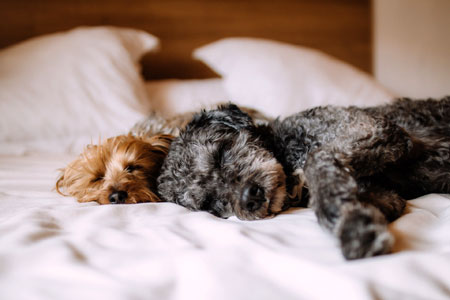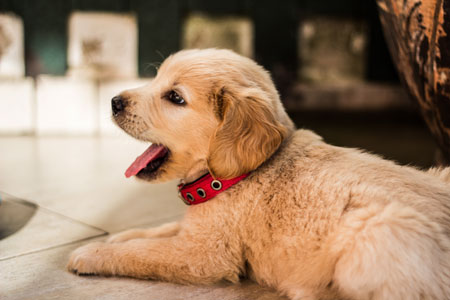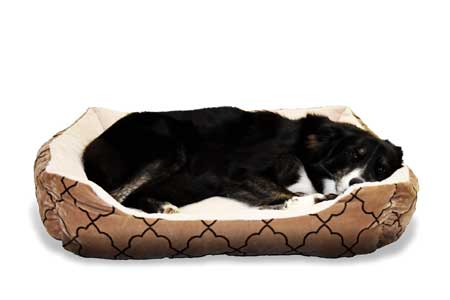Crate Training Your Dog at Night
So you just adopted a puppy or rescue dog. Wouldn’t it be nice if you could snuggle with your dog right away with no problems at all? Unfortunately, you have some work to do. You will want to start crate training your dog at night starting on the first night that you adopt him.
And this is a must if you just adopted a puppy. Older rescue dogs may not need crate training, but you should still use a crate for the first night.
First, let’s cover the reasons to use a crate for your dog. And the tricks you will need to know to get him into the crate.

Crate Training Basics: 4 Reasons to Use a Crate
- A crate can act as a den for your dog, a place to sleep and feel safe.
Dogs have an instinct to sleep in a den. As a result, they take to a crate easily. And they do not like to pee where they sleep.
- They are also good for protecting your belongings while you are not home.
If you adopted a puppy, then they chew everything while they are teething. A newly adopted rescue dog may be anxious and chewing things can alleviate that anxiety. The good news is that rescue dogs should be comfortable with crates.
- Insecure dogs feel safer in a crate.
Do not use a crate that is too big for your dog. It should only be big enough for him to stand up and turn around. The small confined space offers security for the insecure types.
- Stopping “messes” in your house.
Use the crate for housetraining your puppy at night and during the day. It is the best way to stop peeing in the house because dogs don’t like to soil their own “den”. If you let your puppy free-roam in your house, they will pee in one corner and sleep somewhere else. This is one of the best uses for dog crates.
Crate Training Your Dog the First Night: 5 Tips to Get Him Inside

Crate training your dog at night does require you to get him in the crate in the first place. Try the following tips to get him to go inside and enjoy staying in there.
- Introduce your dog to the crate on the first day.
Puppies are easy to get inside of crates. Make getting your dog into the crate a positive experience by repeatedly throwing in treats. Then change it up by giving him a treat AFTER he gets into the crate.
Older adopted dogs may already be familiar with crates. Hopefully, they are used to them and do not have negative associations with them. You will find out how they feel about the crate when you throw treats inside. If he does not go into the crate, then he has a negative view of them (see tip #2 below).
- Feed meals and hide treats in the crate.
This is an extension of tip #1, but instead of throwing a treat inside, feed his meals inside the crate. And on the first night, it would be wise if you divided up the nighttime meal into 2 or 3 portions. That would be 2-3 times that you can get him inside the crate.
But before you feed him those partial meals, hide treats under toys or blankets. And do that when he is not in the room to see you do it. He will smell them. Hopefully, he will view the crate as a place where treats are to be found.
- Keep a chew toy inside.
Puppies need to chew and older gods may chew out of anxiousness from being in a new environment. Kongs are popular especially if they are filled with food or peanut butter. I think it is better to stuff bones with food. You can buy hollow bones from most any pet store. Since Kongs are made out of rubber, it can be a health risk if they chew off and swallow pieces of it.
- Only use a crate for pleasant experiences: treats, food, toys, and sleep.
Do NOT use the crate for punishment or it will be hard to get your dog in there at night.
- Use a simple command to get him to go in the crate
Training your dog to get in his crate at night is the main focus of this article. Try something simple like “crate”, “bed”, “sleep”, etc. Combine the command with pointing to the crate with one hand and have a treat in your other hand. Then close the door when he gets inside.
Tips for Crate Training at Night
Start crate training your puppy on his first night.
It is a good idea to put the crate in your bedroom for the first few nights, especially if you have other dogs so he doesn’t feel isolated. You can try moving the crate farther away each night. In time you can move it to where you want him to sleep each night.
If he cries or whines at night it is either from loneliness, fear, separation or because he has to pee.
But it could be because he has to pee. Take him for a quick walk right before you go to bed. If you are like me, you are super sleepy right before you decide to go to bed. It’s annoying taking your dog for a quick pee break that late, but puppies can’t hold it overnight.
So if he cries after the pee break, then its a test for you. Just deal with it. Do not yell or bang on the crate. That will not help. You are going to lose sleep if you adopt a puppy, Ignore him and don’t open the door.
You can use a pen along with a crate for overnight. Put puppy pee pads in the dog-pen area so he can relieve himself.

Make the crate as comfortable as possible. Put a dog bed or blankets on the floor of the crate. Also, include a bowl of water, but not a lot of water. Just put enough water to last the night.
Also, partially cover the crate to make it den-like. My dog’s crate resembles a small cave.
Make sure your puppy is tired at bedtime by playing during the evening. Take him out for a quick pee break and then get him into the crate with your command.
Final Notes for Crate Training at Night
One advanced option is to plug in an Adaptil diffuser near the puppy’s bed. This gives off the same pheromone as a nursing dog mom and helps the puppy feel safe and secure so they drift off to sleep, instead of the puppy crying at night.
Crate training a dog takes time and consistency. Don’t be discouraged and just keep putting him in the crate each night.
Note: You should not crate your dog for too long. They need exercise and interaction. Puppy max time is 4 hrs. You should consider a dog walker for the days you are at work.
When to Stop Crate Training a Dog
Don’t stop using the crate until you are sure they are housebroken. If you stop crate training too soon, then you may undo everything. You will have to start over. Once you know your dog is “good”, you don’t need to lock them in the crate. It is a good idea to leave the door open as it can become their own personal space.
Also, keep the crate because it’s good if they have surgeries, or you need to put them in the crate for some reason. Reasons to use the crate after he has been trained is if you have workers in your home, or maybe children or an elderly person. You may have to lock the lovable monster away for a little while.
Signs You are Done with the Crate
So how do you know when to stop crate training? When will your dog be ready to free roam your place? When he stops peeing, chewing or barking.
The biggest reason for crate training your dog is so they do not go to the bathroom INSIDE your house. If they can hold it and you give them regular walks, then you don’t need the crate for that reason anymore.
The second reason for crate training your dog is so they don’t destroy possessions that you love. My dog chewed up my favorite baseball hat. I was sad and mad. I was out and the hat smelled like me – he was lonely. You can stop using the crate if he only chews on his chew toys.
The final reason to stop using the crate is if he doesn’t bark all day when you are gone. Dogs with separation anxiety may never be done with the crate. But instead of using the crate for his entire life, you should definitely take him to obedience classes.
Another option is to use a baby gate with an open crate in a room. That entire area becomes their den with the crate acting as his sleeping area. The kitchen or a spare bedroom are good options.
If you are interested, I have a few articles that may be of interest to you. Check out the First-Time Dog Owner Tips and How to Walk a Dog That Pulls articles if they apply to you. And if you are from Philadelphia, I have an article on 14 dog training schools in Philly and their costs. Good luck!




